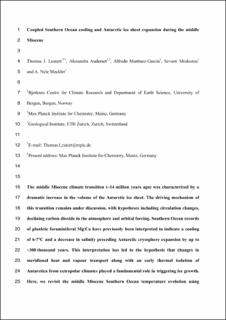Coupled Southern Ocean cooling and Antarctic ice sheet expansion during the middle Miocene
Leutert, Thomas Jan; Auderset, Alexandra; Martínez-García, Alfredo; Modestou, Sevasti Eleni; Meckler, Anna Nele
Journal article, Peer reviewed
Accepted version

Åpne
Permanent lenke
https://hdl.handle.net/11250/2735798Utgivelsesdato
2020Metadata
Vis full innførselSamlinger
- Department of Earth Science [1103]
- Registrations from Cristin [10402]
Sammendrag
The middle Miocene climate transition (~14 million years ago) was characterized by a dramatic increase in the volume of the Antarctic ice sheet. The driving mechanism of this transition remains under discussion, with hypotheses including circulation changes, declining carbon dioxide in the atmosphere and orbital forcing. Southern Ocean records of planktic foraminiferal Mg/Ca have previously been interpreted to indicate a cooling of 6–7 °C and a decrease in salinity that preceded Antarctic cryosphere expansion by up to ~300,000 years. This interpretation has led to the hypothesis that changes in meridional heat and vapour transport along with an early thermal isolation of Antarctica from extrapolar climates played a fundamental role in triggering ice growth. Here we revisit the middle Miocene Southern Ocean temperature evolution using clumped isotope and lipid biomarker temperature proxies. Our records indicate that the Southern Ocean cooling and the associated salinity decrease occurred in phase with the expansion of the Antarctic ice sheet. We demonstrate that the timing and magnitude of the Southern Ocean temperature change seen in previous reconstructions can be explained if we consider pH as an additional, non-thermal, control on foraminiferal Mg/Ca ratios. Therefore, our new dataset challenges the view of a thermal isolation of Antarctica preceding ice sheet expansion, and suggests a strong coupling between Southern Ocean conditions and Antarctic ice volume in times of declining atmospheric carbon dioxide.